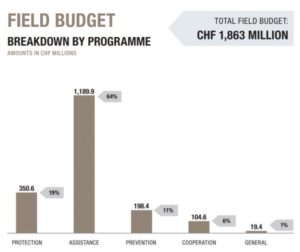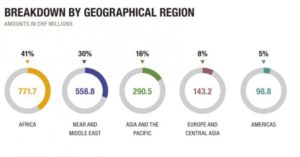“To protect the lives and dignity of victims of armed conflict and violence and to provide them with assistance”
The ICRC stands for the International Committee of the Red Cross; an INGO which began in 1863 with a conference in Geneva, Switzerland. Although only having 5 members, they sought to improve the overall protection of wounded soldiers. Over the duration of a year, those 5 members were able to contact government officials with this proposition to allow armies to care for these wounded soldiers; ending in the creation of the recognizable emblem of the red cross against a white background.
With the effects of the First World War and the Second World War that this organization began to flourish and develop. During the First World War, the ICRC opened a “Central Prisoners of War Agency” with the purpose to connect war prisoners to their families. Battlefields became a place for ambulances to reside to find wounded soldiers and care for them. With a want for peace from the general population, the Red Cross began to shift to support this. However, the ICRC remained present in places such as Ethiopia and South America; still fighting for the protection of prisoners of war. During the Second World War, the responsibilities of the ICRC expanded though including the shipment of relief supplies and exchanging Red Cross messages to families. Post Second World War, the ICRC continues to help and strengthen international humanitarian aid efforts.
Today, the organization “has more than 12,000 staff in 80 countries around the globe” (“The International Committee of the Red Cross (ICRC)”). Although shaped by past World Wars, the ICRC has developed into an organization with many roles and responsibilities in order to help all people affected by armed conflict. Some of the activities completed by the ICRC for those affected are addressing sexual violence, establishing economic security, implementing forensic science, and assisting with providing water and habitat (“International Committee of the Red Cross.”). The above quote at the beginning of this blog post is the mission statement of the International Committee of the Red Cross, which is sought to be completed by such activities. The most important and noteworthy words within this statement are “protect” and “provide” due to that fact that this proves the actions implemented by the staff of the organization.
In terms of finances, the ICRC is funded by “by voluntary contributions from the States party to the Geneva Conventions (governments); national Red Cross and Red Crescent societies; supranational organizations (such as the European Commission); and public and private sources” (“International Committee of the Red Cross.” ). Each year the ICRC re-evaluates the projected budget they anticipate is needed. The below graphs show how the ICRC wants to allocate their assistance through the year 2019. As one can see the ICRC is very organized with their funds and strategically planning how they can best help those in need.
According to a report of the branding toolkit of the International Committee of the Red Cross, their branding “is the sum of people’s thoughts and feelings” about the organization (“Council of Delegates of the International Red Cross…”). Those working for the ICRC want to have people to understand what they are doing, how they are making a difference, and what they stand for. In order to portray this, the report explains that those must work according to the ICRC’s values to prove to the public of the positive effects of the organization.
One of the main critiques of the ICRC can be found within an article entitled “The ICRC is a Paradox” by Victoria Morgan. Some of these paradoxes listed in the article include being “a Swiss private agency with a special status in public international law” and having “liberal goals, but conservative means” ( “‘The ICRC Today Is a Paradox.’”).
References
“International Committee of the Red Cross.” Comité Internacional De La Cruz Roja, 1, 31 Aug. 2016, www.icrc.org/en.
“Council of Delegates of the International Red Cross and Red Crescent Movement Seoul, 16–18 November 2005: Resolutions.” International Review of the Red Cross, vol. 87, no. 860, 2005, pp. 755–827., doi:10.1017/s1816383100184553.
“The International Committee of the Red Cross (ICRC).” What Is Vulnerability? – IFRC, www.ifrc.org/en/who-we-are/the-movement/icrc/.
Morgan, Victoria. “‘The ICRC Today Is a Paradox.’” SWI Swissinfo.ch, Swissinfo.ch, 29 June 2012, www.swissinfo.ch/eng/looking-ahead_-the-icrc-today-is-a-paradox-/32993136.



3 Comments
I didn’t realize just how long ago the ICRC began. It was interesting how you included the whole budget and the breakdown between the programs. I do think it is important that people understand exactly what the ICRC is doing and where their money is going. I think it can often be a problem when people just donate even if they are not sure what they are donating to.
It is interesting to note the paradox of the ICRC and how through there seemingly democratic and liberal mission has evolved and carried out conservative action and policy. We often note how Sweden is systematically neutral in most conflicts yet has indirect involvement through the OHCHR and ICRC and its subsidiaries. Overall great post and thoroughly enjoyed it.
I like how you included how members of the IRC find it important to have others understand what they are doing, rather than just trying to get people to donate. This Is definitely a crucial aspect for humanitarian sectors to do because they get a lot of backlash from people, saying that what they do is not doing anything. However, through this, and the speaker in class today it is evident that humanitarian aid workers do so much, yet it’s so complicated that things may take so long to be fixed.